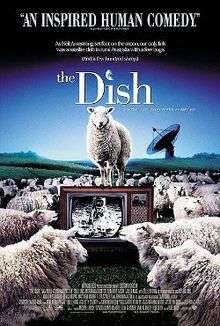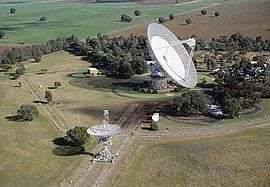The Dish
The Dish is a 2000 Australian historical comedy-drama film that tells the story of the Parkes Observatory's role in relaying live television of humanity's first steps on the Moon during the Apollo 11 mission in 1969. It was the top-grossing Australian film in 2000.
| The Dish | |
|---|---|
 Promotional poster | |
| Directed by | Rob Sitch |
| Produced by | Santo Cilauro Tom Gleisner Michael Hirsh Jane Kennedy Rob Sitch |
| Written by | Santo Cilauro Tom Gleisner Jane Kennedy Rob Sitch |
| Starring | Sam Neill Kevin Harrington Tom Long Patrick Warburton |
| Music by | Edmund Choi |
| Edited by | Jill Bilcock |
| Distributed by | Roadshow Entertainment (Australia) Warner Bros. (North America) Icon Entertainment International (UK) |
Release date |
|
Running time | 101 minutes |
| Country | Australia |
| Language | English |
| Box office | $18 million (Australia) |
Plot
The radio telescope at Parkes (Parkes Observatory), New South Wales, was used by NASA throughout the Apollo program to receive signals in the Southern Hemisphere, along with the NASA Honeysuckle Creek Tracking Station near Canberra.
In the days before the July 1969 space mission that marked humanity's first steps on the Moon, NASA was working with a group of Australian technicians who had agreed to engineer a space-to-Earth interface to carry the video and telemetry signals from the Lunar Lander Eagle on the Moon and relay them to the rest of the global audience, estimated then at some 600 million people. The dish antenna used had to be large, as the signals expected from the spacecraft were very weak and easily lost; NASA had to use the Parkes radio telescope, situated in the middle of an Australian sheep farm. There were some background concerns at NASA about using the Parkes antenna, mainly technical, as the signals had to go via point-to-point microwave links to get re-transmitted globally.
Based on a true story, The Dish takes a sometimes comical look at the differing cultural attitudes between Australia and the U.S. while revisiting one of the greatest events in history. It depicts the activities in a control room of a radio telescope doing a job it was not originally expected to do. The film depicts some animosity between the Australian staff and the NASA representative, but they come together as a team when one of the locals fails to properly service a backup generator, putting their part in the mission at risk. They apply all their science skills to re-acquire the signal and cover their mistake, so that everything works out in the end. The directors of the film portray, quite accurately, what is in essence a complex technical task, such as re-pointing the dish when it loses the signal's "lock" and deciding to use it when the wind whips up threatening to damage and even destroy the structure. The film dramatises the team-work of a few technicians, who sometimes nearly lose their tempers with each other, painted against a backdrop of proud Australian townsfolk, with visiting dignitaries including the U.S. ambassador, hoping nothing will go wrong.
Accuracy
Although the film is based on actual events, it uses fictional characters and alters historical details for dramatic effect. NASA's Honeysuckle Creek and Goldstone stations both had the signal first, but Parkes's signal was used soon after the beginning of the moonwalk.[1] Armstrong's first step on the Moon and his words, "That's one small step for [a] man, one giant leap for mankind", were transmitted to Earth by the signal from Honeysuckle Creek.[2] No power failure occurred, there was no friction with the NASA representatives (of whom there were not just one but several),[3] and Prime Minister John Gorton visited Honeysuckle Creek, not Parkes.[1] They did, however, operate in very high winds gusting to 110 km/h (68 mph) at 60 degrees inclination, risking damage to the dish and even injury to themselves to keep the antenna pointed at the Moon during the moonwalk.[4]
Cast
- Sam Neill as Cliff Buxton
- Patrick Warburton as Al Burnett
- Tom Long as Glenn Latham
- Kevin Harrington as Ross "Mitch" Mitchell
- Roy Billing as Bob McIntyre
- Eliza Szonert as Janine Kellerman
- Tayler Kane as Rudi Kellerman
- Billy Mitchell as Cameron
- Roz Hammond as Miss Nolan
- Christopher-Robin Street as Damien
- Luke Keltie as Graeme
- Naomi Wright as Melanie
- Ben Wright-Smith as Nicholas
- Beverley Dunn as Secretary v/o
- Grant Thompson as Mr. Callen
- Bille Brown as Prime Minister John Gorton
- Lenka Kripac as Marie McIntyre
- Neil Pigot as the newspaper reporter
- Frank Bennett as Barry Steele
Production

Much of the film was shot on location; the "cricket match" and "hayride" scenes were shot on the real dish and researchers often postponed experiments to position the dish for photography.[5] The set reconstructing the 1969 control room was extremely accurate, down to some details as small as ashtrays. Some of the "props" were in fact original NASA equipment used during the Apollo 11 landing, left behind in Australia as they were too heavy (i.e. too expensive) to ship back to the U.S.[5] Staff from that era expressed amazement at seeing the set; they said it was like stepping through a time warp.[5]
The Dish was written by Santo Cilauro, Tom Gleisner, Jane Kennedy and Rob Sitch, and directed by Sitch.[6][7]
Apart from the radio telescope scenes, the majority of the movie was actually filmed in the small town of Forbes, 33 km (21 mi) south of Parkes because of its old historic buildings, and also in Old Parliament House in Canberra, and Crawford Studios in Melbourne.
Box office
The Dish grossed $17,999,473 at the box office in Australia,[8] and was the top grossing Australian film in Australia in 2000.[9]
Reception
On the review aggregator website Rotten Tomatoes the film holds a 96% fresh rating.[10]
References
- Tink, A. A. (Andrew Tink) (2018), Honeysuckle Creek : the story of Tom Reid, a little dish and Neil Armstrong's first step, NewSouth Publishing, ISBN 978-1-74223-608-7
- Sydney Morning Herald: 20 July 2019: Andrew Tink: News Review p.29
- Barkham, Patrick (25 May 2001). "Dishing up an Australian legend". The Guardian. Retrieved 1 October 2018.
- "Apollo 11 Moon landing". Commonwealth Scientific and Industrial Research Organisation. Retrieved 24 October 2015.
- "The Dish Official Site - Production notes (Flash)". Warner Bros. Archived from the original on 28 January 2012.
- Bradshaw, Peter (11 May 2001). "The Dish". the Guardian. Retrieved 1 October 2018.
- Holden, Stephen (14 March 2001). "A Weak Link, But You Still Want to Cheer". New York TImes. Retrieved 1 October 2018.
- "Australian Films at the Australian Box Office" (PDF). Film Victoria. Archived from the original (PDF) on 23 July 2011.
- "Box office: Australia: Top 5 each year". Australian Film Commission. Archived from the original on 29 March 2002. Retrieved 2 October 2018.
- "The Dish". Rotten Tomatoes. Retrieved 1 October 2018.
External links
| Wikiquote has quotations related to: The Dish |
- Official website, thedishmovie.warnerbros.com (2012 archive)
- The Dish on IMDb
- The Dish at Box Office Mojo
- The Dish at Oz Movies
- The Apollo 11 Story on the Parkes Observatory website
- The Dish: Fact versus Fiction — a quick comparison
- Josh Olson on The Dish at Trailers from Hell